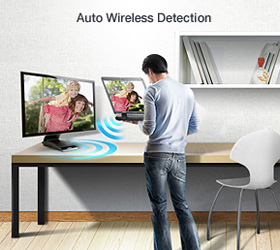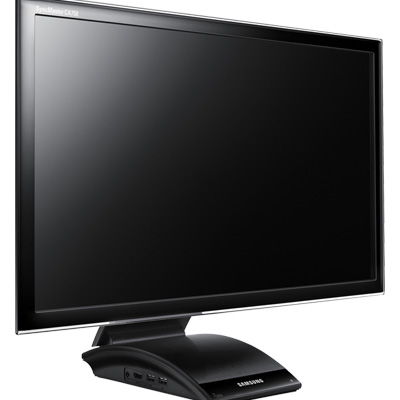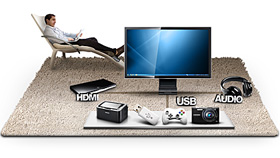
Original Link: https://www.anandtech.com/show/4446/samsung-central-station-future-of-laptop-docking
Samsung Central Station: The Future of Laptop Docking?
by Kristian Vättö on June 14, 2011 11:30 PM EST- Posted in
- Displays
- Samsung
- Central Station
- Laptops
Back at CES 2011, Samsung showed us something that may have seemed a bit futuristic back then but which is now reality. They showed us a monitor that connects to your laptop wirelessly and on top of that, the monitor acts as a USB hub and the USB devices connect wirelessly too. Samsung calls this technology Central Station. You simply connect a small USB dongle to your laptop, take the laptop within the monitor’s range and your laptop automatically connects to the monitor and peripherals attached to it, wirelessly. You walk away and the monitor goes black. Pretty simple, right?

Background
During the last few years, laptops have become powerful enough for people to use as their main computer. Sales figures support this too. If we look at for example Apple’s sales figures, twice as many desktops were sold compared to laptops in 2002. However, during the recent years, laptops have stolen a huge portion of the sales of desktops, making the situation the opposite of 2002: laptops now outsell desktops by a two-to-one ratio.
While laptops can now offer performance sufficient for some real work, there is one thing that they cannot offer: screen real estate. Most laptops have around a 15” screen, but resolutions vary a lot depending on the model and price range (1366x768 at the low-end, and up to 1920x1200 in higher-end models). 22-24” monitors with resolutions of 1920x1080 have more or less become the standard for desktops and such monitors can be had for ~150$ nowadays.
Because laptops lack screen real estate, a laptop with a separate monitor at home has become a very common setup. This gives you portability when on the go and a desktop-like setup when at home with extra screen size/resolution. However, this kind of setup has one big setback in that you need to plug in a bunch of cables when you get home to use your external monitor and other peripherals. With a desktop, you just turn the computer on or wake it up from the sleep mode; there's no hassling with cables required. While you could call one lazy if it’s too much to plug in a few cables, you often end up either using the laptop on the desk with the monitor all the time, or you never plug in the monitor and it sits on the desk unused.
Laptop docking stations have offered a solution, but there are several shortcomings. First off, not all laptops have a design suitable for docking (Apple’s laptops come to my mind). Second, each laptop dock is only suitable for certain laptop models, so if you buy a new laptop you most likely have to buy a new laptop dock as well. A new dock will easily set you back at least $100, which is quite a lot for an ugly piece of plastic. Finally, many consumer laptops don't even have suitable docks, which rules out a docking station completely.
This is where Central Station becomes interesting. You don't need to connect any cables and you don't need an ugly dock. Everything is wireless.
Features and specifications
Central Station is not available yet but Samsung has updated their product page to include specifications for two soon-to-be released monitors utilizing Central Station:
| Central Station Product Comparison | ||
| C23A750X | C27A750X | |
| Screen size | 23" | 27" |
| Resolution | 1920x1080 | 1920x1080 |
| Brightness | 250 cd/m2 | 250 cd/m2 |
| Response time | 2ms | 2ms |
| Viewing angles | 170°/160° | 170°/160° |
| Color support | 16.7 million | 16.7 million |
| Video inputs | HDMI, VGA | HDMI, VGA |
| Other inputs | 2x USB 3.0, 2x USB 2.0, Megabit Ethernet | 2x USB 3.0, 2x USB 2.0, Megabit Ethernet |
| Outputs | Audio out (3.5mm), USB 3.0 | Audio out (3.5mm), USB 3.0 |
| Dimensions (WxHxD) | 21.7" x 17.1" x 9.2" | 25.1" x 19.1" x 9.2" |
| Weight | 9.7 lbs | 11.5 lbs |
| Price | $449 | $599 |
As the table shows, the only differences between these two are the screen size, dimensions, and price. Both offer the same resolution, brightness, viewing angles, and other features.
Update: Best Buy is selling the 23" model for $449 and Micro Center is selling the 27" model for $599 so it appears that the rumored prices were correct.
The Screen
Screen wise these new monitors remind me of Samsung’s Class 550 Series monitors which offer the same screen sizes, resolution, brightness etc. It could be that these monitors are actually using the same panels with just the Central Station hardware bundled with them. The viewing angles suggest that the panel type is TN, which might be bad news for people who need more accurate colors, or just an overall better quality display.

Ports
Each monitor has a total of four USB ports. Two of them are USB 3.0 but here comes the downside of using a wireless connection: your bandwidth will be limited to USB 2.0 speeds when connecting wirelessly. Samsung acknowledges that USB 2.0 speeds may not always be enough, and thus a USB 3.0 output is also present so if you want to enjoy USB 3.0 speeds; you just plug in a single USB 3.0 cable to your laptop and you can use the USB 3.0 devices connected to your monitor at full speed. However, this kind of kills the idea of paying extra for Central Station technology as there are plenty of other monitors and USB 3.0 hubs that can basically do the same thing for less money.

Samsung says that the wireless range is 5 feet, which means that you have to be on the same desk to use this feature without lag, so don’t imagine sitting across the room and using the screen as it won’t work. While wireless connection is the selling point of Central Station, these monitors also come with VGA and HDMI connections, so for instance you can plug in a Blu-Ray player and use the monitor “normally”. There is also a 100Mb Ethernet port (yeah, you heard it right, Megabit) which can be useful for businesses if there is no WiFi due to possible security concerns.
Ergonomics
The stand offers height adjustment so using the monitor should be comfortable no matter how tall you or your desk are. For a dual display setup, it’s even handier because you can adjust the display to be on the level of your laptop’s display (or very close to it). There is also something that Samsung calls MagicAngle which lets you to adjust the angle of the monitor.
System Requirements
Windows XP and Windows 7 will be supported at launch, but users of Windows Vista and Mac OS X will have to wait for a driver, which is set to be released later in 2011 (NY Times quotes October). On the hardware side, Samsung states that a 2.2GHz Core 2 Duo or better is required along with 2GB of RAM. Intel, ATI/AMD, and NVIDIA graphics are supported but it’s unclear whether this includes all GPUs made by these companies or only certain models. A 2.2GHz Core 2 Duo actually sounds pretty high as a requirement; personally I would expect Central Station to run fine on a 2010 MacBook Air, which has a slower CPU.
Performance
Samsung claims Central Station is based on their own technology but unfortunately we don’t have any further details of what this technology holds inside. The technology shouldn’t, however, interfere with WiFi or Bluetooth so you don’t have to worry about messing up other connections. Samsung promises USB 2.0 speeds over the wireless connection so that would be a maximum of ~40MB/s in real world, which is quite a bit faster than what you currently get with 802.11n.
Update: As noted in the comments, Samsung uses UWB (Ultra-wideband) for wireless connection. It's the most suitable for small range connections which explains Central Station's 5 feet range. Some laptops even have UWB built-in (e.g. Samsung 9 Series) so they can connect to Central Station without the USB dongle.
CNET ran a couple of tests on their review unit and it turned out to be okay for videos and gaming. There was definitely a loss in quality but CNET claims that it’s not very noticeable and most users won’t see the difference. It’s quite obvious that these monitors aren’t a gamer’s choice anyway due to the price and poor panel type, but it’s good to see that it can manage such tasks if needed. I was actually fairly surprised to read that it can do any gaming or movie playback as I was expecting stuttering, especially with HD movies and any serious gaming. As it handled gaming okay, day to day tasks should run without a hiccup. Unfortunately we don't have a review unit (yet) so we cannot do our own extensive testing of the performance and Central Station in general.
Final thoughts
At $449 for 23” and $599 for 27”, Central Station is dangerously close to being overpriced. While it’s not too expensive for someone who really wants the features on offer, it’s not cheap enough for the mainstream audience. As mentioned earlier, a similar 23" display without Central Station can be had for around $150 so you could buy three such displays for the price of the 23” model. However, if you need a laptop dock as well, the price might not be so bad since a good dock will easily be over $100, and there are laptops that don't even have a docking option. In that case, Central Station is only $100-200 more expensive, but you get a wireless docking station that can be used with future laptops.
The biggest market for Central Station is clearly people who move their laptop a lot but still want a big screen when at their desk, with a fast and seamless connection method. I would expect business users to be a big market as they usually don’t need gaming or movie playback capabilities but often move their laptop around. Imagine that you are working on a document and you have to leave to a meeting very quickly. You just grab the laptop in your hand and leave; no need to undock or disconnect cables. You come back and after a few seconds, you can continue to work on your spacious monitor. Before Samsung updated their product page with full specifications, it actually mentioned two separate models for business use but the updated page has no reference to them.
It will be interesting to see whether other manufacturers will follow Samsung and come up with something similar. If there is a decent market for something like this we could see some degree of competition, which should provide more options and better prices. I’m pretty sure Samsung is already working on bringing Central Station to their TVs, but the range needs to be extended for such use. I also hope there will sooner than later be a monitor with 2560x1440 or 2560x1600 resolution that will support Central Station or equivalent technology. 1080p is okay but if I’m going to pay $150 more for the 27” model I'd want a higher resolution. I would rather pay $999 and get a nice resolution as well (though the bandwidth required to transmit 2560x1440 without lag could be too much).
All in all, Central Station is a very interesting concept and it seems to be something that we will hear about in the future. These are the first monitors to support it so they won't please everyone, but this is definitely a good start.







